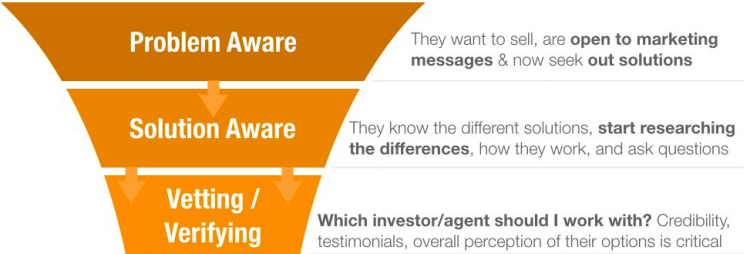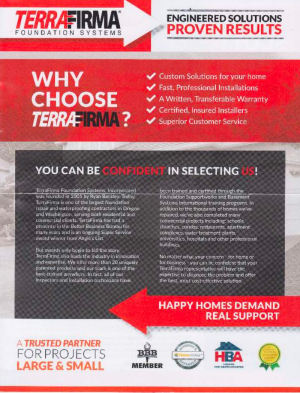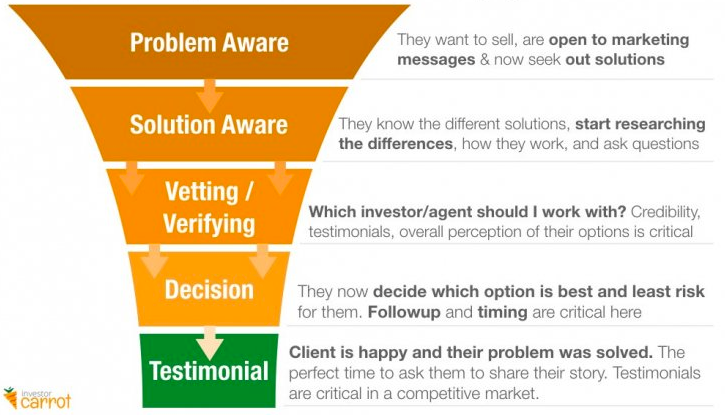
What if you could read the mind of the motivated seller? Meaning, what if you could send the right message to the right person at the right time?
Unfortunately, the internet provides a threat to match its opportunity. While powerful, the internet’s power can easily be strangled by its formidable size. Quickly, it becomes a source of crowded destruction instead of open possibility.
The real estate market is increasingly competitive because it’s increasingly cluttered, making the dream of reading the house seller’s mind, at the least, difficult, and at the worst, debilitating.
But here at Carrot, we hate letting dreams die.
Every year, our clients pull in over 400,000 online leads, giving us a very special position to speak to what’s happening in the real estate market.
Even though the market is more crowded than ever before, by accepting this density and optimizing your customer experience for the motivated seller, that crowded room becomes a pleasant dinner party. And you’re the host.
So, how do you cater and attract a motivated house seller?
Well, you need to know what the motivated seller thinks, wants, and does. Lucky for you, we crunched some numbers, ran some tests, and stepped into their mind… using a significant and varying sample size, specific to all seller websites we host.

And we want to share what we learned.
So, before we finish wiping off brain matter, here’s how the motivated seller makes the decision on who they’re going to work with when selling their house… based on our years of research and understanding the “decision lifecyle” of the average motivated house seller.
Let’s Get Inside The Mind Of A Motivated House Seller On Their Path To Choosing A Company That Can Solve Their House Problem
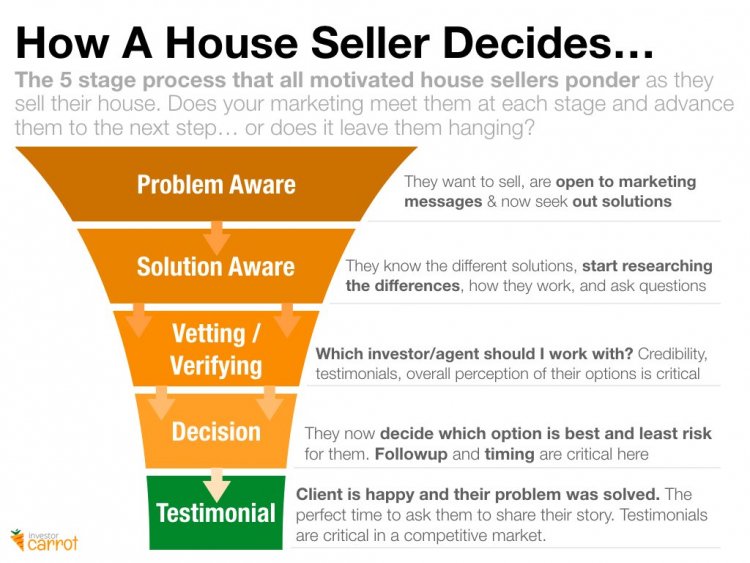
Step 1: Problem Aware
The house seller knows they have a problem… but aren’t sure how to best solve it. This is where you come in…
At this stage the motivated house seller is thinking…
“I need to get this house sold, like soon.”
This is the birth of the motivated seller.
Maybe they received a job in a new state, a family has fallen sick, foreclosure, inherited a house, going through a divorce, or just simply have a house that needs lots of repairs that they don’t want to deal with. Regardless of the reason, life circumstances spiked their curiosity in the selling process and they start exploring the possibility.
First and foremost, the seller wants to know how much they can likely sell their house for. They’ll likely visit Zillow, update their house information, and then check out their Zestimate.

Image via Zillow
But, while Zillow offers convenience, John Wake’s guess work, on Real Estate Decoded, estimates that Zestimate’s typical error is plus or minus 14,000 dollars.
And whether the motivated seller has run their own tests or not, their trust for this system is limited. It offers a curiosity-sating foundation, but not a real-time solution.
Which is good. Because you are the real-time solution they are looking for.
That takes us to the seller’s second dig: they contact someone who can answer their questions in greater depth.
Likely, this is someone the motivated seller’s acquainted with, whether it be a friend, a Facebook ad, or a Twitter feed. Whatever the case, they are looking to make phone calls and get answers.
It’s your job to (1) get them to call you, and (2) provide those answers.
Here’s how.
1. Get In Front Of Them Where They Search… Google
House sellers will hit Google to search things like “how to sell my house fast” or “selling a house in divorce in dallas” to find basic info about their options.

If you’re ranked high in Google with SEO or PPC and you deliver great content on your site that clearly shows them that you have a service that can solve their problem… you’ve just met them exactly where they are in the decision cycle.
2. Direct Mail
At this point, your prospect is also now receptive to marketing messages that look like they’ll solve their problem.
You dig through the mail. After tossing the credit card offers and ripping up the bills you’ll just pay online later, you come across a handwritten letter. Whoa! That’s unusual, you think. You quickly check your mental calendar to see if today is your birthday. Maybe your aunt has sent a card with $5 inside. Nope. What’s going on?
Maybe the letter is from the local movie theater, maybe it’s from a church, or maybe it’s from a local real estate investor.
Maybe it’s from you.
The point is that everyone gets a lot of mail, but if you make your letter stand out from the rest, people will feel that much more a part of your tribe.
Direct mail isn’t dead. In fact, since it is slower than nearly every other medium of communication, that snail-like pace has romanticized its effect. Like candlelight and bathtubs, the receiver feels like they’ve been transported back to better, more personal, times, and because of that, it has an intimate feel… if it’s done right.
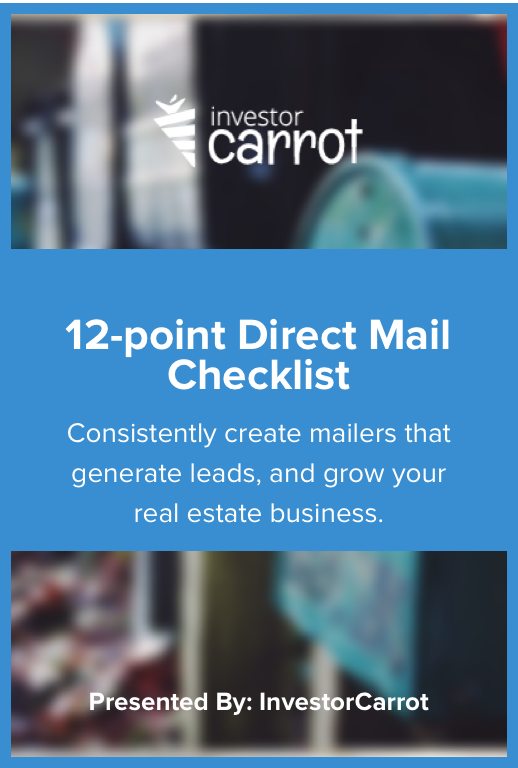
12-point Direct Mail Checklist for Real Estate Investors and Agents
A checklist to ensure consistently remarkable mailers that generate leads, grow your business revenue and make your campaigns more sustainable.
3. Social Media Presence
Don’t break the bank for Facebook advertisements. But do maintain a social media presence — post on your account regularly — as a preemptive strike to the motivated seller’s subconscious.
When trying to decide who to contact with all of their questions, the seller thinks, “Hey, I remember seeing real estate investor, Joe the Pro’s [this is you], posts on Facebook. He seems like he knows what he’s doing. I’ll contact him!”
In fact, second, only to Direct traffic, Social Media wins when it comes to acquiring new sessions on your website.
Some ads that just let them know your service exists will be perfect for this phase. Like…

or…
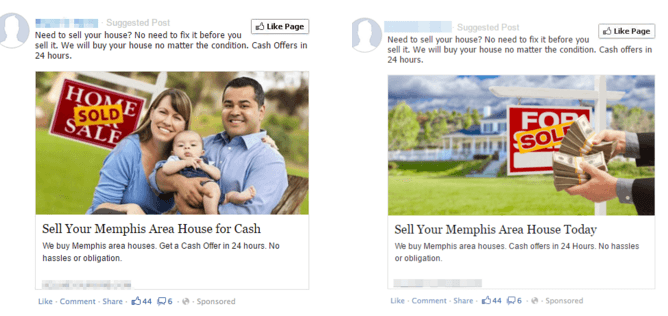
Play with the endgame in mind. The more people who notice you on Social Media, the more people who’ll contact you when they decide to sell their house — which we all will at some point.
Marketing Tips For This Phase:
- Do more broad marketing as targeted as possible
- Focus on just letting them know you have a service that can solve their biggest needs (speed, convenience, no fees, no agents, etc.)
- Bonus: Have your ads drag them to the next phase (Solution Aware and Vetting / Verifying) w/ testimonials in your ads
Step 2: Solution Aware
They know their basic options, agents vs. investors… they just need to research more to see what’s best for them.
At this phase the house seller is likely thinking…
Ok, cool… it looks like there’s options… but how are agents different vs. investors and which is best for me?
At this point, the motivated seller Google’s phrases such as, “Sell my house fast [insert their location],” “Agent vs. Investor,” or “Professional home buyers.” They’ve decided to sell their house, now they’re deciding the best way to go about it.
It’s critical that you get noticed.
Why?
Because our data shows that motivated sellers aren’t wasting any time. They make a decision on who to work with faster than you can paint a bedroom: 0-days fast.
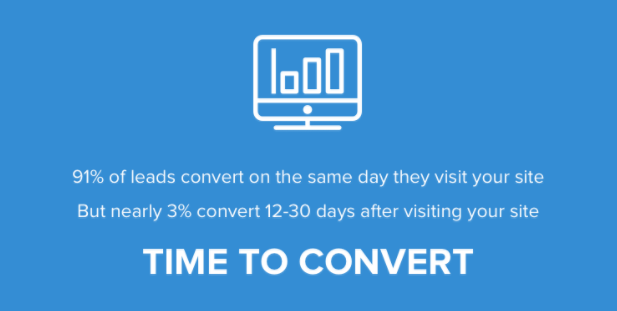
You need to be prepared for this. When the motivated seller decides who to work with, if you’re not able to answer their questions, someone else is, and they’ll choose that someone else.
Here’s how to raise your hand first.

The One Mindset Difference Between Top-performing Real Estate Investors and Everyone Else
Learn the dead-simple difference between those who build thriving businesses and those who never fulfill their dreams or goals.
4. Content Structure That Pulls The Prospect To The Next Phase Effortlessly
Most websites and marketing don’t think through the order that their prospect thinks when making a decision. They don’t take into account what info the house seller needs to have before the next piece of info will be useful to them.
Take a look at this Carrot site as an example… from a client who has been a part of over 3,000 transactions.
This Content Flows The Way Sellers Make Decisions: Does Yours?

Does your marketing skip phases and leave your prospect hanging with questions?
Or does your site only focus on making sure they know you can buy a house but not on pulling them through the next phases proactively?
5. Blogging
The sheer amount of blogs on the internet is debilitating. It seems like everyone and their pet blogs.
But, as you know, since everyone else is doing it, it’s hard to get noticed if you’re not.
The good news, though, is that even with the massive amount of online content, the motivated seller isn’t threatened. They still view blogs and spend an average duration of 1:05 looking.

Due to the increased visibility it creates, your blog is a great way to answer the motivated seller’s questions as they type them into Google, increasing traffic, forcing you to learn your stuff, and building relationships with the people who want to help you make money.
If you want to take up blogging — which you should — check out our post on how to do that, with actionable examples.
6. Local Content
No need to work in a massive school of fish. Your real estate business is local to a few spots. Optimize your website content and rankings by using locally appropriate titles and blogging subjects that will cater directly to people in the area.
When the motivated seller searches, “Sell my house quick in Roseburg, Oregon,” you’ll be at the top. Because other real estate investors aren’t including “Roseburg, Oregon” in their content.
Unless, of course, they also work in Roseburg…
But it’s a whole lot easier to compete with a few local real estate investors than it is the whole nation. Since you’re not selling or buying properties in every state, don’t create content that competes nationwide. Create content that competes locally and you’ll be more visible to the people who matter.
7. Ads That Compare + Educate On The Options + Process
In this phase, you can’t keep on sending people ads and direct mail that just tells them that you can buy their house. They already know. So here’s where you need to retarget your prospects w/ ads that educate and compare… while at the same time adding credibility to pull them to the next phase.
Like…
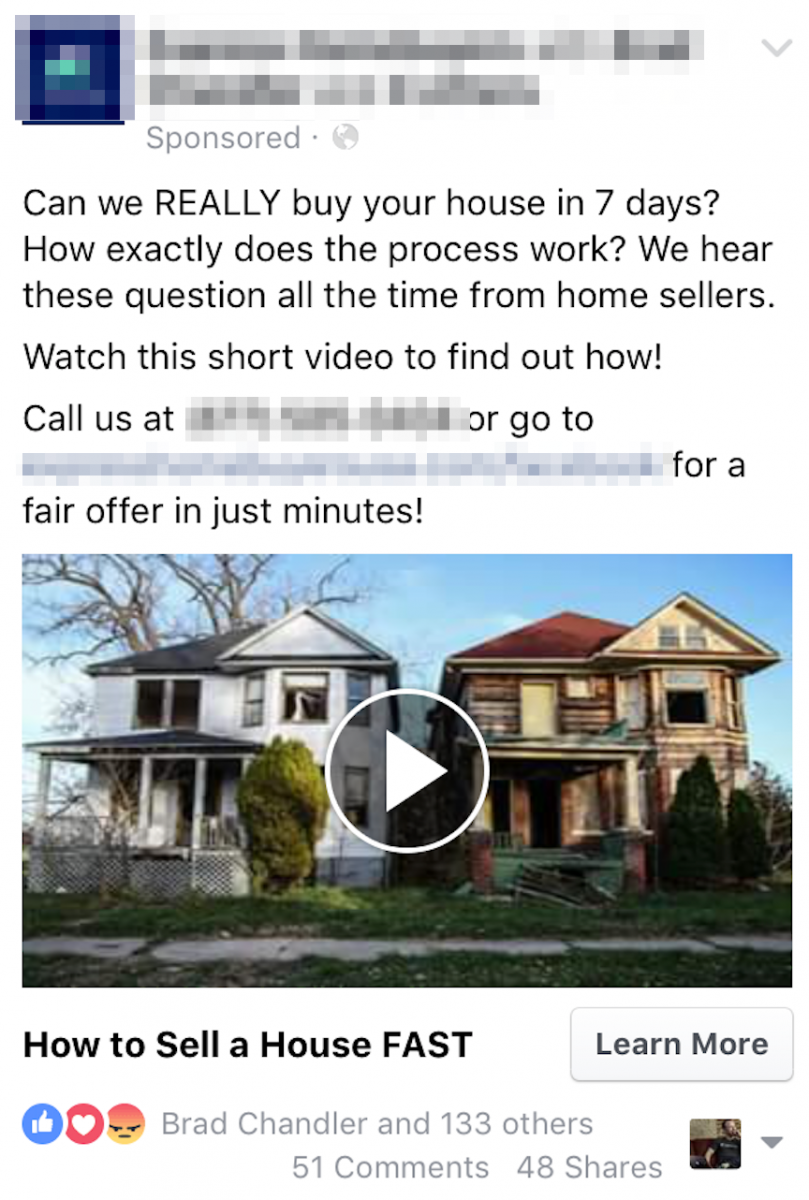
… and one of our own (one of the highest performing ads we have, it drives to a blog post of ours)
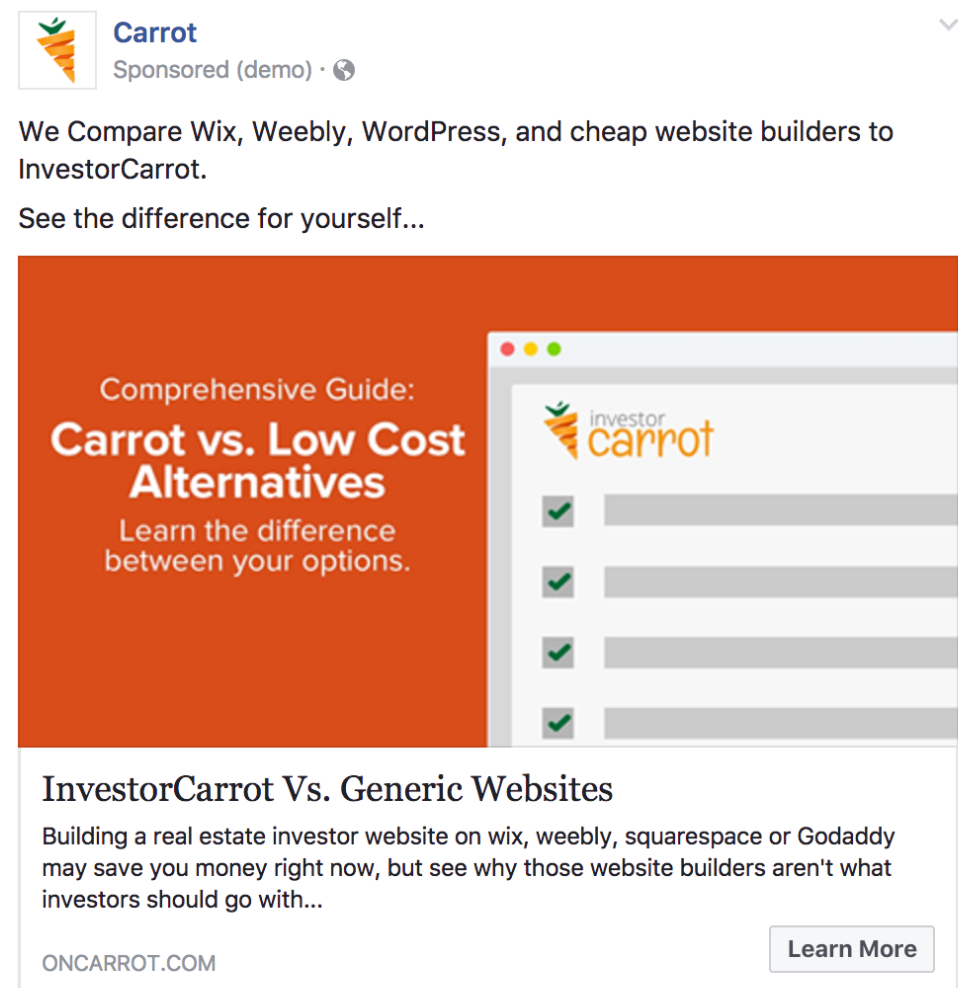
Marketing Tips For This Phase:
- Start to retarget your prospects on Facebook with a mix of ads that educate and compare. Comparing your USP to theirs is critical
- Build your website and your marketing so it flows the way your prospects decide
- Bonus: Again, if you can have a testimonial do the heavy work for you, educating your prospect for you… it automatically pulls the prospect past the next phase… building credibility for you in the process
Step 3: Vetting and Verifying
The seller recognizes their problem, they know the basics of the options… but who should they work with?
In this phase the seller knows they have a problem that they want to be solved fast, they basically know the options and how they work… but now their main question is…
Which company should I work with? Which is the most credible?
They’re asking if they want to work with you. Your job is to convince them that they do.
How?
The homepage is where the motivated seller often lands, and not just lands, but commits… or at least turns into a lead.
If they’re not ready to become a lead… they then explore the website to find answers to their questions or verify suspicions.
What Pages Do Most Most Leads Come From? [our data]
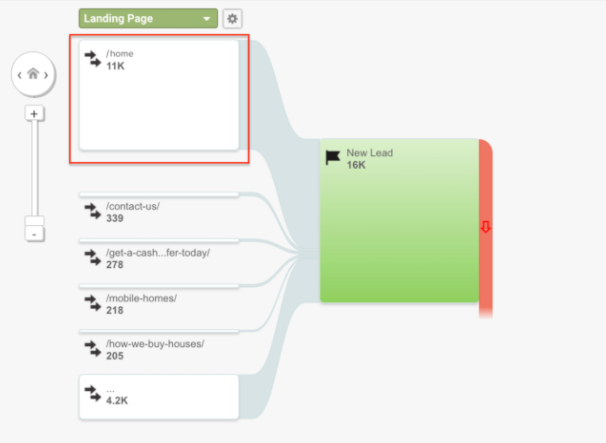
Since the homepage is playing such a significant role in determining your leads and, thus, your conversions, here’s a few things to think about when trying to attract motivated sellers.
- Create a high converting house seller home page
- Build an amazing About Us page to build the story of who you are and that you’re real people. It’s critical.
- Don’t just cater for those ready to opt in right now, include robust content that builds your expertise, credibility, and makes it easy for them to contact you
But how can you best build credibility and get an edge on your competition since your prospect already knows that you both can provide essentially the same service?
Let’s start here…
8. Easy Contact Options + Great About Page
The ease with which you create this page is not equal to the breadth of its importance.
Overall of the seller websites we host, the “contact us” page sports compelling numbers.

For an even faster transition from homepage to lead, provide the option to bypass the “Contact Us” page with a “Call Us: XXX-XXX-XXXX” CTA.
Notice The Interaction With The Easy Opt-In Form And Phone Number
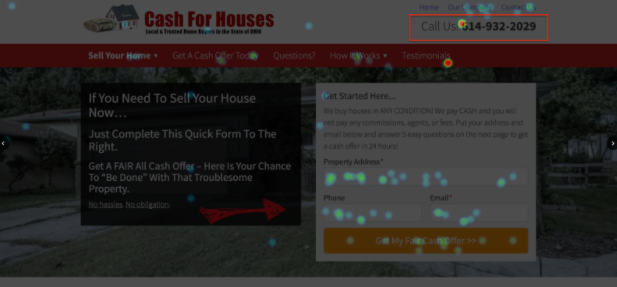
As you can tell, a Christmas tree would have trouble competing with that red-hot dot. Consider putting your phone number on the homepage to reduce the number of clicks needed to go from viewer to lead. Fewer clicks mean more conversions.
During this beginning phase, the seller has a lot of questions. Your “Contact Us” page, or “Call Us” corner, gives them the opportunity to get in touch with you and inquire. You’ll be positioned like a pro and, more importantly, make a valuable connection.
Also, as the seller does their research… they’ll hit your about page.
Our research shows that often times the About Page is always one of the top 3 most visited pages on a real estate website no matter the type of site.
A Heat Map Of A Carrot Clients Site: Our Company Is Hot
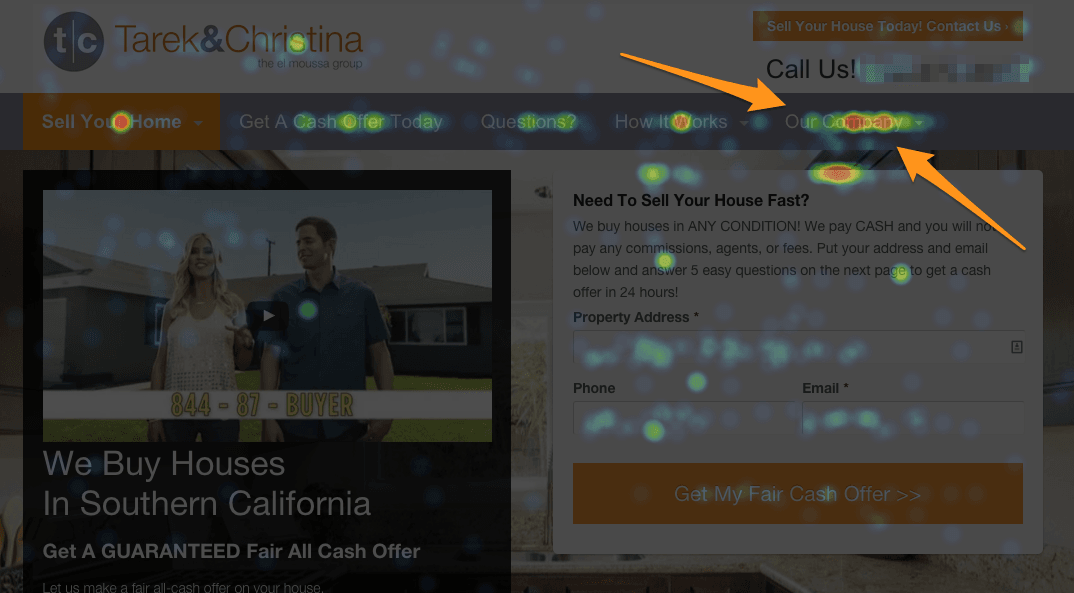
A Heat Map Of Our Site (previous version) Shows The Same
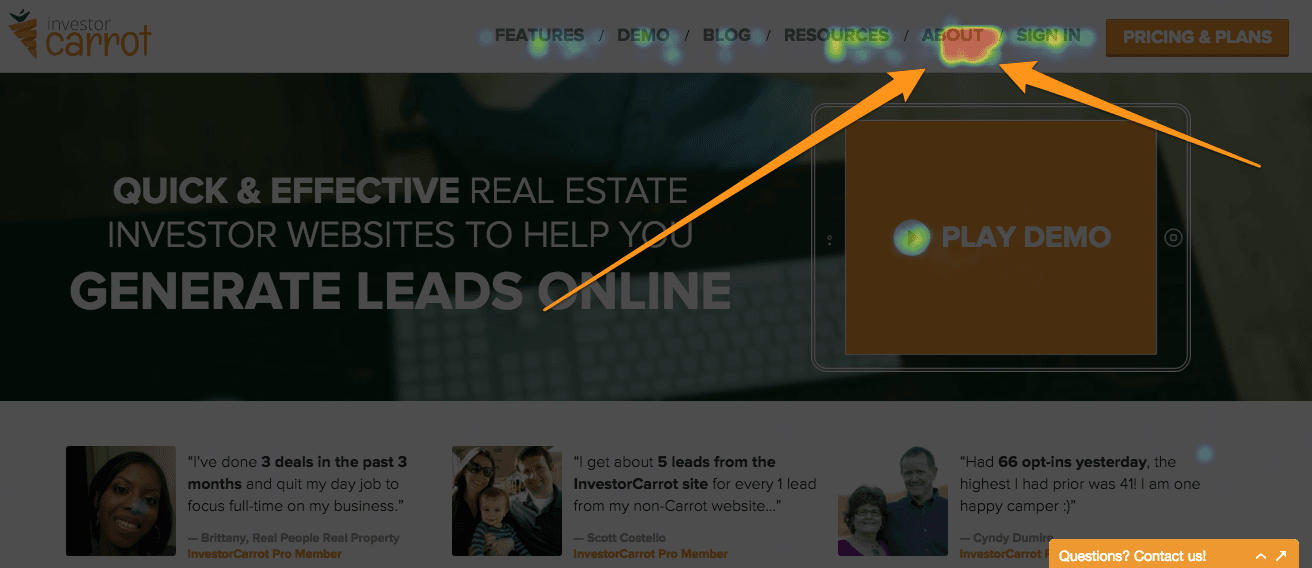
Get faces on your About Page like Carrot clients CR Homes of Maryland.

9. Build Your Credibility
In this phase, credibility is key.
We’ve seen time and time again where a house buyer with a lower offer has won the deal simply because they did a better job building credibility with the seller. In fact, in a CarrotCast interview I did with top investor Martin B. out of Phoenix, he talks about examples of how they overcome and win even when there are multiple offers higher than theirs.
Show them ads that build your credibility… seller testimonials are great for this.
On this website, our heatmap shows that testimonials are playing a critical role.
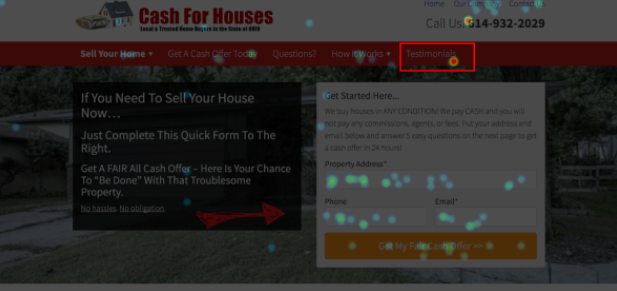
Like…
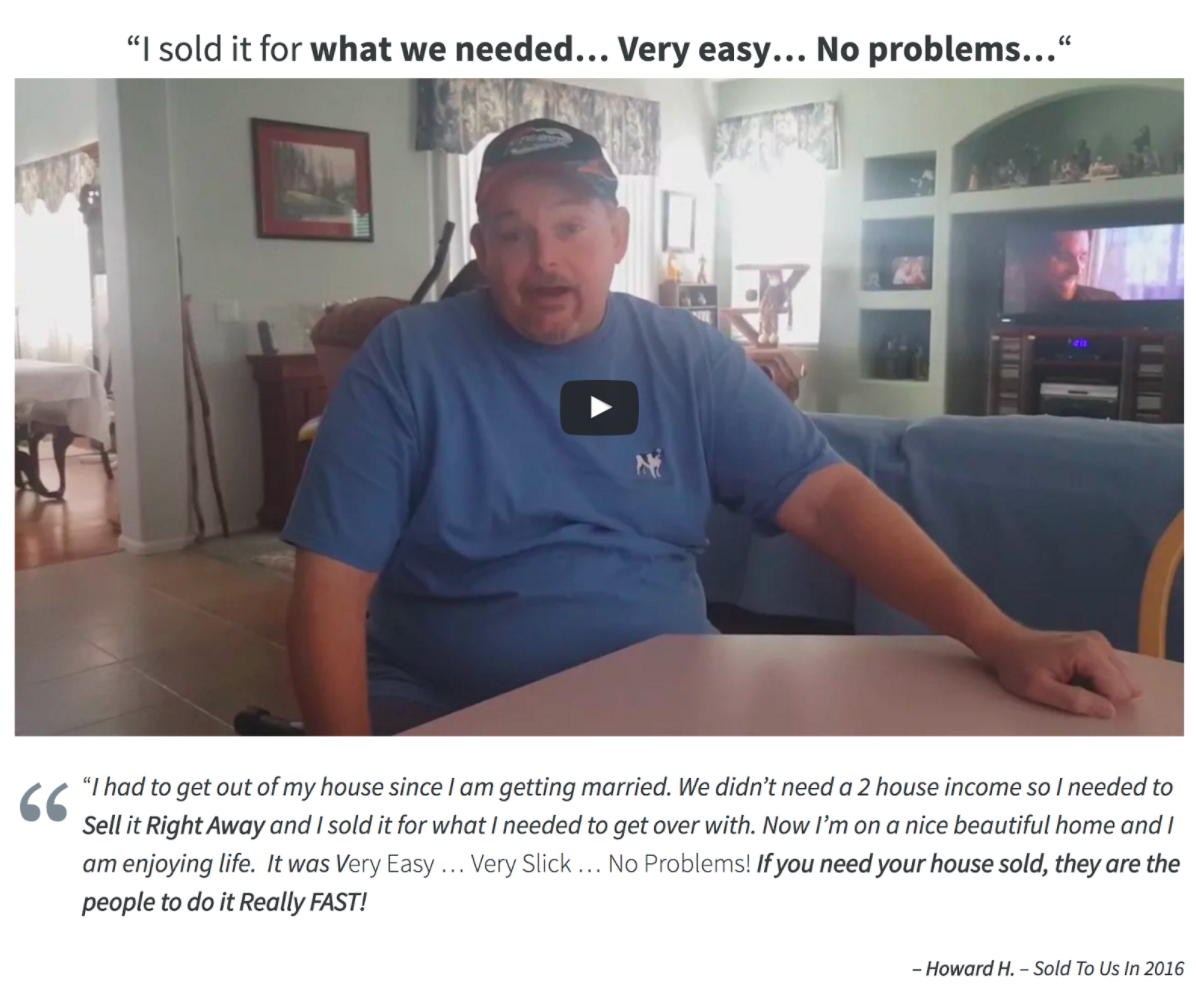
The best testimonials are short and shining.
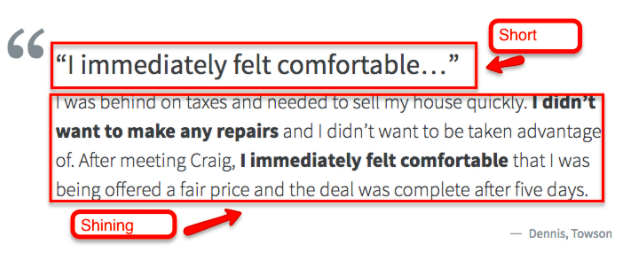
Or use direct mail to build your credibility like the example we used in this CarrotCast episode on Credibility…
And make sure to use credibility badges where you can to add that 3rd party validation to your credibility profile.
And last, make sure to control your brand conversation online when people are verifying and vetting your brand through Google searches. Like…
Your Sellers Are Actively Searching For Reviews + Your Reputation… What Do They See?

Hopefully you’re controlling the conversation around your brand so your sellers don’t bail at the last moment in this phase. Control it like this…
Notice How Their BBB Profile, Facebook, And Carrot Site Control The Brand Convo
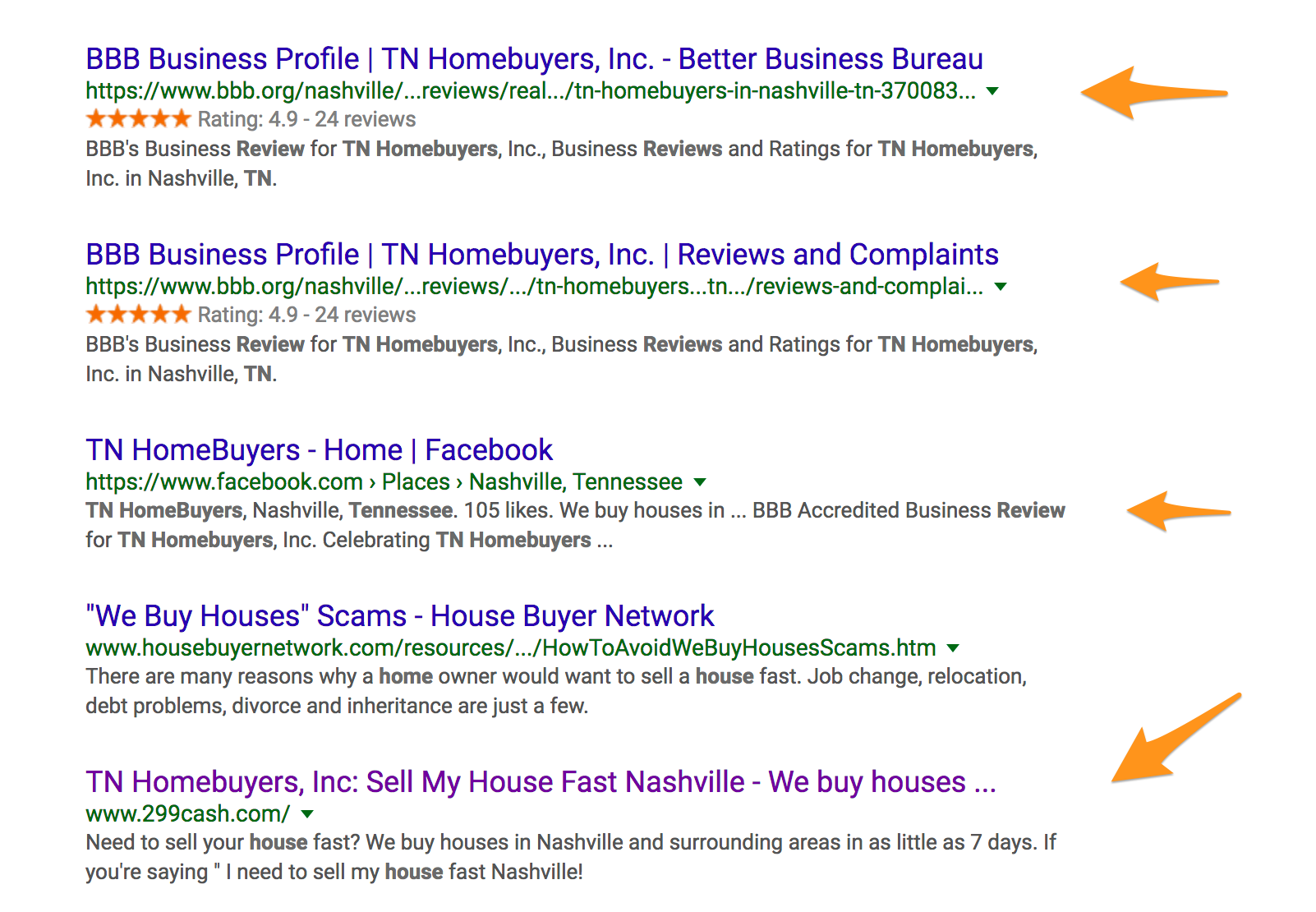
The biggest missing factor in your ads, your direct mail, and your online marketing strategy is credibility. Credibility trumps any marketing tactic out there.
If you’re offering the same service as the next guy, it’s going to come down to credibility and your offer. That’s it.
10. Clarity
Stumbling upon a cluttered website is an immediate no-go for the motivated seller. Where clarity communicates professionalism and ease of use, clutter communicates a lack thereof.
But what is clutter?
Clutter might translate into the too-much-stuff-on-one-page category, but not necessarily. Consider the apparent “clutter” of a top online store, Amazon.
What Is Clutter? It’s Not Clutter If It Get’s You What You Need…

Image via Amazon
As you can tell, there’s a lot going on. And this goings-on could easily be classified as clutter.
And yet, they’re winning.
Don’t think of clutter as having too much on a single web page, think of clutter as having too much that distracts from your CTA. Amazon wants you to get lost in the shopping experience, and thus it shows you a plethora of items you may or may not be interested in, much like browsing at the mall.
But you’re not trying to sell products ranging from laundry detergent to Harry Potter collectibles.
Your product is an easy and fast process for the house seller.
To sell that, you don’t want a lot of action items.
As a bad example, consider this website… for whom the brand name has been blocked out.
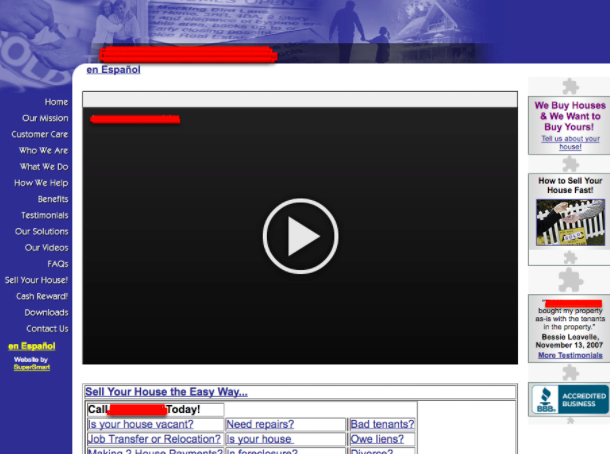
This website is a disaster. Most importantly, It has painfully positioned CTA’s…

With this many Call’s To Action, you can be sure that none deliver. This is clutter. Clutter means that when someone visits your website, they’re not sure what you offer, or where you want them to click.
In contrast, clean and clear as a windexed window, check out this example.
Full Of The RIGHT Information But Not Devoid Of The Info
Your Prospect Needs To Advance To The Next Phase
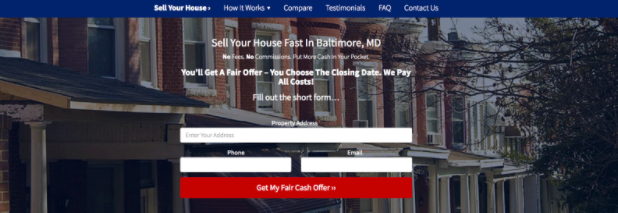
Image via SpeedyHomeBuyersMD
This homepage immediately communicates what it offers, whether or not I — the motivated seller — am in the right place, and what I should do if I am (fill out the information).
A website this clean will perform better simply because it communicates better. Get harsh on your own website and, if needed, ask for an opinion from a friend — a friend who’ll be honest.
11. Focus On Mobile
The reality is that over half of your traffic is coming from mobile devices.
We Always Display The % Of Mobile Leads On The Bottom Of Our Site

Mobile isn’t the future… it’s here today.
But that’s okay… so long as your website is flexible and optimized to look great on any device.
If it isn’t, though, it might end up looking something like this.
Not User-Friendly On Mobile, Is Yours? (non-Carrot site)
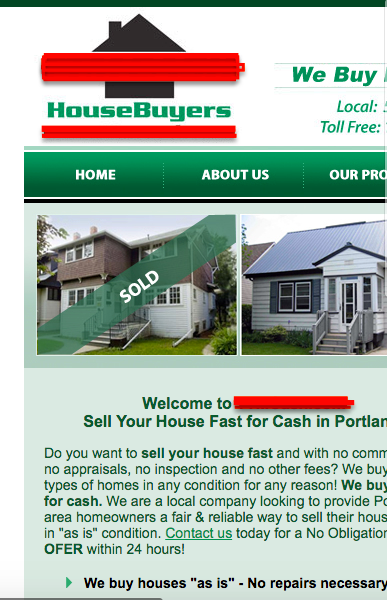
Half the text is covered and navigating becomes a challenge rather than a pleasure. On the other hand, check out this flexible Carrot website.
Clear, Clean, And Great On Mobile (A Carrot Site)
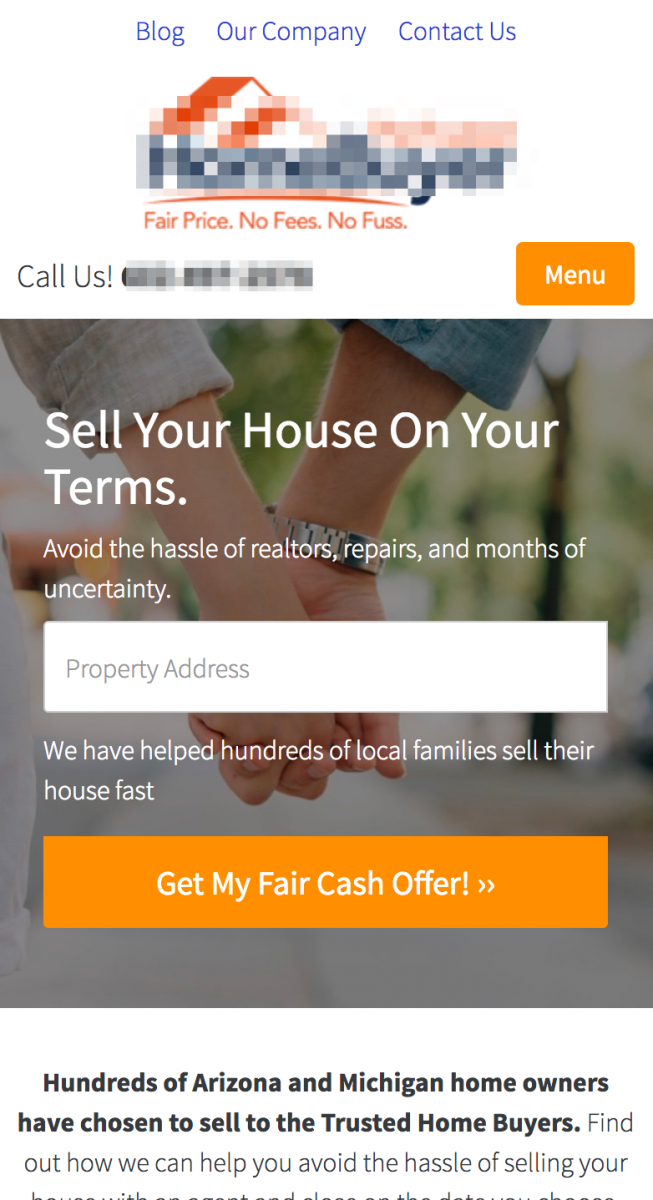
All Carrot websites are mobile-friendly because we understand the importance of it.
Grab your phone and test your own website.
Because having a mobile-friendly website is as important for visitors as having toilet paper for house-guests. It’s just expected.
Marketing Tips For This Phase:
- After someone opts into your site, retarget them on Facebook with testimonial ads
- Build a physical credibility packet and mail that to your prospects overnight, email it to them, and take it to your in-person meetings
- Add at least 5-10 great testimonials formatted correctly to your site
- Build reviews on 3rd party sites like the BBB, your Facebook page, and Google local.
Step 4: Making The Decision
Here, they’re ready to decide. Are you making it easy?
At this phase the motivated house seller is likely thinking…
Ok, lets get them to give me an offer… then I’ll pick the best fit.
Are you making it easy and are you reinforcing their decision to work with you EVEN AFTER THEY CALL YOU OR OPT IN?
The motivated seller has taken the first step, but still, they could abandon.
However, it is too early for you to give up.
There are two primary tools in your arsenal to make them comfortable, and they both focus on transparency: honesty about what you offer, what the seller should expect, how a price is decided, and who you are.
The two tools are (1) the How It Works page and (2) the About Us page.
12. A “How It Works” Page
The “how it works” page is clicked wildly, so don’t hesitate to make this a priority.
See This Part Of A Recent Heat Map On A Carrot Site

But, be careful that you don’t over explain. The seller has questions, but they aren’t in regard to the nitty gritty of your job. Their questions are in regard to how you will benefit them and what they need to do to make it happen.
It can be hard to anticipate all of these questions, so here’s a list of the ones you must answer.
- How long until you contact me?
- What happens when you contact me?
- How is a price decided?
- After we agree on a price, when do I get my money?
In fact, this is beautifully done on FLA Home Solutions.
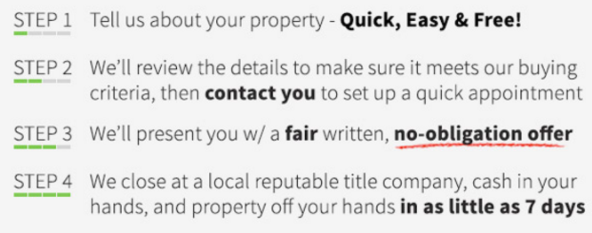
They make it easy to understand, quick to read, and, most importantly, only answer the questions that the motivated seller is asking.
13. A Strong Hero Section
Like every great story, someone needs to save the day… or rather, something. And that something should be your product.
Your hero should sit at the top of the homepage and quickly tell the visitor that (1) they’re in the right place and (2) you’re here to solve their problems.
As you can tell on the below heatmap, the hero is viewed as often as the bat-signal is flicked.
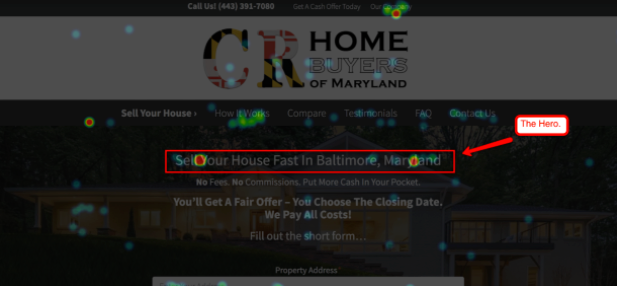
Don’t get creative at the cost of clarity. Your hero should be similar to the above. Something regarding selling fast, since you’re marketing to the motivated seller, and location, because the motivated seller is searching for someone in their area.
Once the seller is convinced that you’re the hero they’re looking for, it’s time to swoop in and actually save the day.
14. A Clear CTA (Call To Action)
Everyone loves this part of the story. This is where the motivated seller takes the first leap, which is usually providing you with contact information.
This is your first CTA, and arguably, the most important.
If the motivated seller doesn’t give you permission to contact them, they aren’t serious about working with you.
Since your business goes nowhere without this first step, it’s important to make it simple, directly after the hero, and, ultimately, the focus of your homepage.
Consider how your eyes flow first to the hero of this snapshot, and then seamlessly to the CTA.
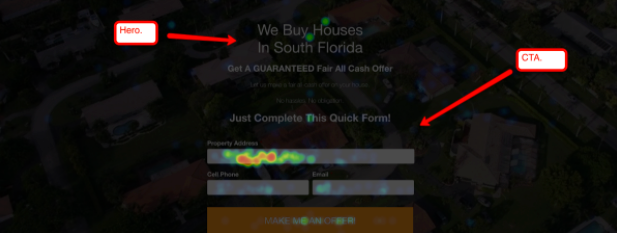
Also, consider this example, differing in setup, but equally effective in conversion.

Whatever the hero to CTA transition on your website, make sure it’s obvious and smooth. Since the motivated seller is in a hurry, your homepage should be too.
Heck, even put clear calls to action in your Facebooks ads at this phase, like…
15. Follow Up, Follow Up, Follow Up
Often times they’re just not ready to make a decision yet.
So make sure you’re putting your leads into an email, text, and possibly direct mail followup system.
We see clients pulling deals out 6+ months later after the lead initially came in.

The One Mindset Difference Between Top-performing Real Estate Investors and Everyone Else
Learn the dead-simple difference between those who build thriving businesses and those who never fulfill their dreams or goals.
Schedule The “8 Word Email” To Go Out In 6 Months
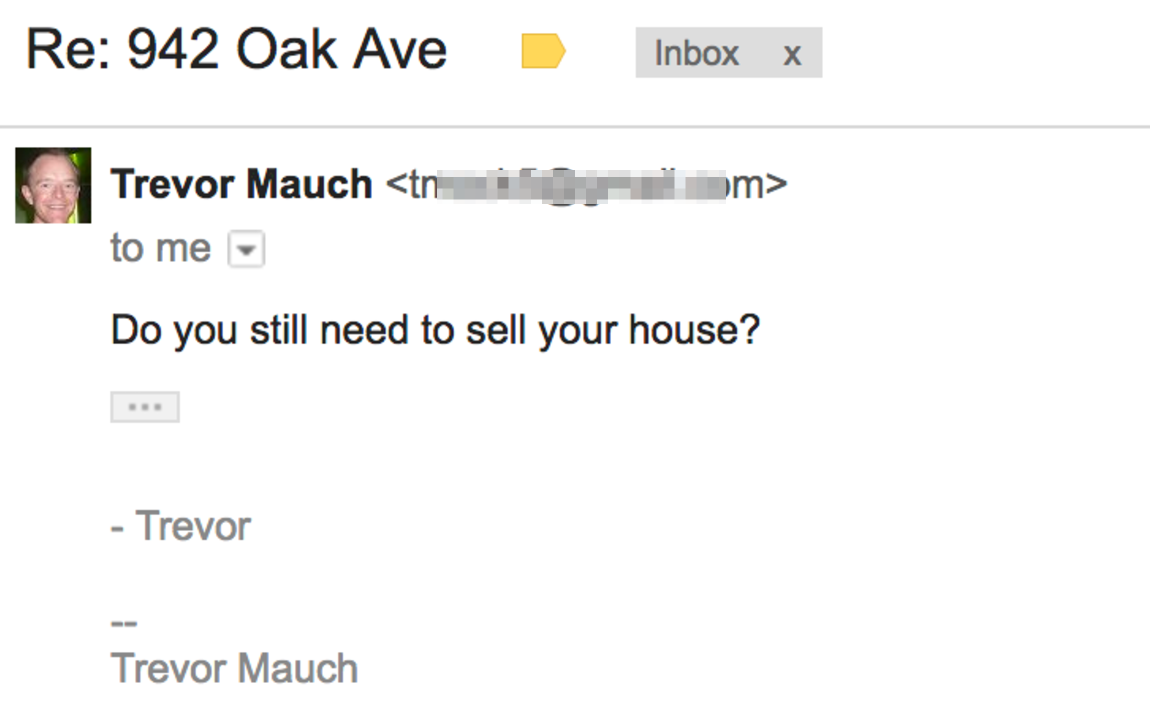
Marketing Tips For This Phase:
- Create a simple email sequence that goes out 6+ months. At month 4-6 hit them w/ the “8-word email”
- Have Facebook ads that ask… “Still need to sell your house?”… then drive them to a testimonial on your site
- Make it easy for people to get in touch with you… phone, text, opt-in online
Step 5: Turn Clients Into Testimonials Then Repeat The Above
At this point, you’ve got a client and closed deal! But the work doesn’t stop…
Right here your client is happy with the service, and this is the best time for you to ask for a testimonial or referral.
Adjust Your Marketing + Messaging To Pull Clients Through The Decision Lifecycle
Whew! That was a lot.
But this is the difference between the A Players in real estate marketing and the B or C players.
Most investors make all of their marketing focus on just one or two of the phases… and leave it open for their competitors to better connect with the prospect when the prospect needs it most.
This is just the tip of the iceberg.
So… go out and find where you can better cater your marketing toward the phase of the decision lifecyle your motivated house sellers are in.
Here’s a recap…

And what to do about it…
- SEO and PPC for problem aware people looking for solutions
- Canvas direct mail to those likely to be problem aware
- Engage on social (broad ads)
- Structure content to pull people to the next phase
- Blog (show your expertise)
- Local content
- Ads that compare + educate
- Great about page and clear contact info
- Build your credibility
- Clearly, relay the message of how you can help them
- Focus on mobile
- Great How It Works page
- Strong hero section on your website
- Clear call to action
- Follow Up, Follow Up, Follow Up
Don’t hesitate. Don’t procrastinate.
Go crush it like the mind-reading real estate guru you are.


